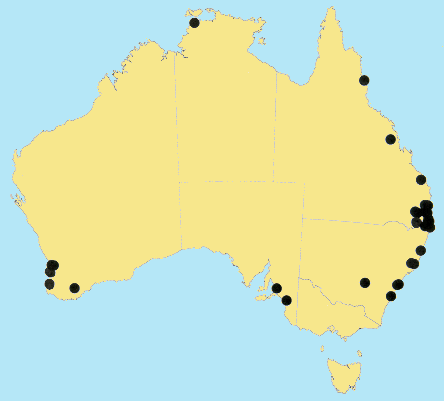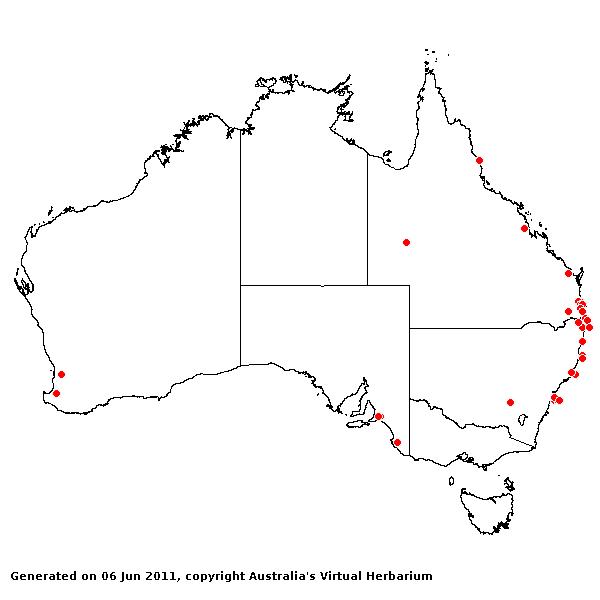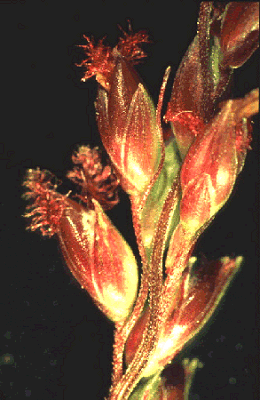Setaria palmifolia* (Koenig) Stapf. J.
Linn. Soc., Bot. 42: 186 (1914).
Classification. (GPWG 2001) : Subfamily
Panicoideae. Paniceae.
Basionym and/or
Replacement Name: Panicum
palmifolium J. König, Naturforscher 23: 208 (1788).
Type of Basionym or
Protologue Information: T: Ex Herb. Desfont. s.n., no date, Unknown:
(US-978043 (fragm. ex FI)). HT: Koenig s.n., Thailand? (BM).
Key references
(books and floras): [2002] D.Sharp & B.K.Simon, AusGrass, Grasses of
Australia, [2002] J.Wheeler, N.Marchant & M.Lewington, Flora of the
South West (433), [2006] J.Jessop, G.R.M.Dashorst, F.M.James, Grasses of
South Australia (482), [2008] S.W.L.Jacobs, R.D.B.Walley &
D.J.B.Wheeler, Grasses of New South Wales (369).
Illustrations:
[2006] J.Jessop, G.R.M.Dashorst, F.M.James, Grasses of South Australia (482, Fig. 415), [2008] S.W.L.Jacobs,
R.D.B.Whalley & D.J.B.Wheeler, Grasses of New South Wales, 4th edn
(369).
Habit.
Perennial. Rhizomes present. Culms erect or geniculately ascending, stature
robust to moderate, 70–300 cm tall. Mid-culm nodes pubescent. Leaf-sheaths
hairy. Ligule a fringe of hairs. Leaf-blades linear or elliptic, plicate, 5–80
cm long, 15–80 mm wide. Leaf-blade surface scabrous, glabrous or indumented.
Inflorescence.
Inflorescence compound, a panicle. Panicle ovate, effuse, 40–80 cm long, 20–40
cm wide.
Spikelets.
Spikelets pedicelled, 1 in the cluster. Involucre composed of bristles. Fertile
spikelets 2-flowered, the lower floret barren (rarely male), the upper fertile,
comprising 1 basal sterile florets, comprising 1 fertile floret(s), without
rachilla extension, elliptic or ovate, dorsally compressed, 2.5–3.9 mm long.
Glumes. Glumes
thinner than fertile lemma. Lower glume ovate, membranous, without keels, 3
-nerved. Upper glume oblong, 1.6–2.5 mm long, membranous, without keels, 5–7
-nerved. Florets. Basal sterile florets 1, male or barren, with palea or
without significant palea. Lemma of lower sterile floret 100 % of length of
spikelet, membranous, 5 -nerved.
Fertile lemma 2.5–3.7
mm long, without keel. Lemma apex mucronate. Anthers 3.
Continental
Distribution: Africa, Temperate Asia, Tropical Asia, Australasia, Pacific,
North America, and South America.
Australian
Distribution: Western Australia, Northern Territory, South Australia,
Queensland, New South Wales, Norfolk I, Lord Howe.
Western Australia: Drummond. Northern Territory:
Darwin & Gulf. South Australia:
Southern Lofty, South-eastern. Queensland:
Port Curtis, Leichhardt, Darling Downs,
Moreton. New South Wales: North Coast,
Central Coast,
South Coast, Central-Western Slopes.
Notes.
Setaria palmifolia belongs to a complex of closely related species that
are characterized by a perennial habit and plicate leaves. Relationships among
the species of this complex are poorly understood and their placement in Setaria
needs critical re-evaluation.
In tropical and
subtropical rain forests, tropical and subtropical wet sclerophyll forests, dry
sclerophyll forests, Brigalow forests, tropical and subtropical sub-humid
woodlands, and semi-arid shrub woodlands. Flowers Mar.-June.




